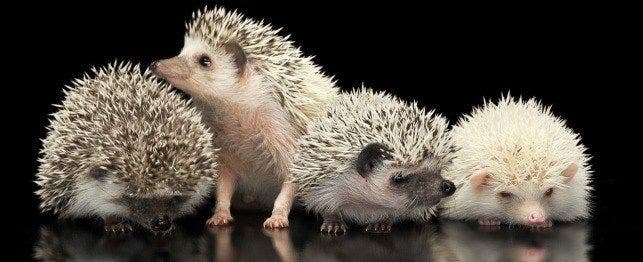
Choosing a Hedgehog
If you live in England or Europe – native territory of the European hedgehog – you may consider these spiny little animals as common as squirrels. You may even put out a bowl of food to encourage them to visit your garden where they will dine on slugs and insects that would otherwise damage your plants. And should you find one that’s been hurt, you could even take it to a hedgehog hospital, say, St. Tiggywinkle’s in Buckinghamshire run by The Wildlife Hospital Trust.
If you’re looking for a pet, however, the wild European hedgehog is not the one you want. What you want is the African pygmy hedgehog, a hybrid of Algerian and white-bellied hedgehogs that is native to Africa and Asia.
Appearance
European and African hedgehogs belong to the same family, Erinaceidae, and the same order, Insectivora, and are relatives of shrews and moles, animals that live mostly on insects and invertebrates. Hedgehogs are small animals, about the size of guinea pigs, from 5 to 9 inches long, weighing anywhere from half a pound to a little more than a pound.
Through breeders’ efforts to create new varieties, there are now some hundred color variations on the natural agouti – gray-brown spines with cream tips. Their most distinctive feature is their quills or spines. These stand up (and feel like) the bristles on a hairbrush. When hedgehogs are frightened or sleeping, they will use their strong abdominal muscle to draw themselves into a ball about the size of a grapefruit, exposing to predators just a mouthful of spines.
Housing
Hedgehogs may appear slothlike but they are agile climbers so it’s best to keep them in a glass-walled enclosure. A large aquarium, 20 gallons or more, will keep them at home. The major concern with aquariums is that if exposed to sunlight they can get very hot. So make certain the top of the aquarium is covered with a mesh screen and that it’s kept away from sunny windows.
The bottom of the tank should be covered with shredded newspaper or pelleted paper, which can be purchased at pet stores. Paper is cheap, absorbent, and easy to dispose of and replace. Avoid pine or cedar shavings since these contain volatile oils that can irritate your animal’s respiratory tract, skin and feet. Since hedgehogs are prone to skin problems from contact with feces or urine, clean the feces promptly and change the bedding when it gets damp or soiled.
Like many small mammals, hedgehogs need places to retreat, especially during the day when they sleep. Provide a plastic container with a hole in its side, a wide diameter section of PVC pipe, or a clay or plastic flowerpot into which they can climb or crawl.
Feeding
Hedgehogs primarily sleep during the day and forage for food in the evening. For this reason, the main meal should be offered later in the day when they are more active. However, you can leave small amounts of food in their cage for them to snack on throughout the day.
Low-calorie dry cat food with some fruits and vegetables should be the mainstay of your hedgehog’s diet. The cat food should be a high-quality brand such as Eukanuba or Science Diet, which provides nearly the appropriate amount of protein (30 to 50 percent) without too much fat (not more than 20 percent). This also will allow your “hedgie” to get the right amount of calcium.
While insects won’t provide all the nutrients necessary for a healthy pet, crickets and mealworms should be included in your prickly friend’s diet as a protein source, as well as a source of mental stimulation. Be sure your crickets and mealworms are on a good diet that includes extra calcium to boost the nutrients received by your hedgehog. Calcium deficiency from a strictly insectivorous diet can cause metabolic bone disease.
Special Concerns
A couple of other unique adaptations: Hedgehogs are immune to some very powerful toxins. They can eat poisonous scorpions and have been known to eat small poisonous snakes without ill effects. When presented with a new smell or taste they will salivate heavily and begin to twist themselves about, spreading the taste or odor all over their bodies in what seems to be (researchers are not certain) an attempt to disguise their own odor with the new odor. This behavior is called “self-anointing.”
Hedgehogs naturally hibernate when conditions are not right or, in the case of wild European populations, during the winter months. Spring is for mating, summer for brooding the hoglets, as they’re known. Fall often brings on another brood. They are also nocturnal, which, for the prospective pet owner, is perhaps the animal’s most notorious habit. In captivity, then, they will be at their most active and playful at night.
When kept in captivity, they are prone to obesity.